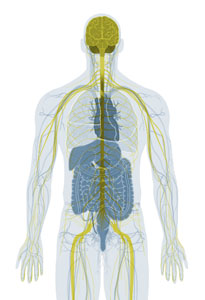 The nervous system receives and sends signals throughout the body to control bodily functions. The nervous system consists of the central nervous system (brain and spinal cord) and peripheral nervous system (nerve fibers that attach to and lie outside the brain and spinal cord). The nervous system has two components, motor (efferent) and sensory (afferent), that carry information from and to, respectively, the central nervous system. The brain is the organ of thought, emotion, and processing of the various senses and communicates with and controls various other systems and functions. The nervous system also provides special senses such as sight, hearing, taste, feel, and smell. It uses the eyes, ears, tongue, skin, and nose to gather information about the body's environment.
The nervous system receives and sends signals throughout the body to control bodily functions. The nervous system consists of the central nervous system (brain and spinal cord) and peripheral nervous system (nerve fibers that attach to and lie outside the brain and spinal cord). The nervous system has two components, motor (efferent) and sensory (afferent), that carry information from and to, respectively, the central nervous system. The brain is the organ of thought, emotion, and processing of the various senses and communicates with and controls various other systems and functions. The nervous system also provides special senses such as sight, hearing, taste, feel, and smell. It uses the eyes, ears, tongue, skin, and nose to gather information about the body's environment.
Click on a substance to go to the health effects chapter in the toxicological profile. Then, search on any target organ system to find the health effects information on that system.